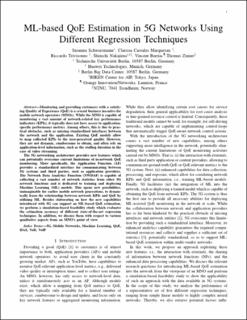| dc.contributor.author | Schwarzmann, Susanna | |
| dc.contributor.author | Marquezan, Clarissa Cassales | |
| dc.contributor.author | Trivisonno, Riccardo | |
| dc.contributor.author | Nakajima, Shinichi | |
| dc.contributor.author | Barriac, Vincent | |
| dc.contributor.author | Zinner, Thomas | |
| dc.date.accessioned | 2022-09-08T05:57:37Z | |
| dc.date.available | 2022-09-08T05:57:37Z | |
| dc.date.created | 2022-09-05T11:48:53Z | |
| dc.date.issued | 2022 | |
| dc.identifier.issn | 1932-4537 | |
| dc.identifier.uri | https://hdl.handle.net/11250/3016441 | |
| dc.description.abstract | Monitoring and providing customers with a satisfying Quality of Experience (QoE) is a crucial business incentive for mobile network operators (MNOs). While the MNO is capable of monitoring a vast amount of network-related key performance indicators (KPIs), it typically does not have access to applicationspecific performance metrics. Among others, this is due to practical obstacles, such as missing standardized interfaces between the network and the application. Existing QoE models allow to map collected KPIs to the user-perceived quality. However, they are not dynamic, cumbersome to obtain, and often rely on application-level information, such as the stalling duration in the case of video streaming. The 5G networking architecture provides new features which can potentially overcome current limitations of in-network QoE monitoring. More specifically, the Application Function (AF) provides a standardized interface for communicating between 5G systems and third parties, such as application providers. The Network Data Analytics Function (NWDAF) is capable of collecting a vast number of network statistics from other 5G network functions and is dedicated to training and deploying Machine Learning (ML) models. This opens new possibilities, unimaginable for earlier mobile network generations, to dynamically learn the relationship between network KPIs and QoE by utilizing ML. Besides elaborating on how the new capabilities introduced with 5G can support an ML-based QoE estimation, we perform a simulation-based feasibility study which evaluates the estimation accuracy of different state-of-the-art regression techniques. In addition, we discuss them with respect to various qualitative aspects from an MNO’s point of view. | en_US |
| dc.language.iso | eng | en_US |
| dc.publisher | IEEE | en_US |
| dc.title | ML-based QoE Estimation in 5G Networks Using Different Regression Techniques | en_US |
| dc.title.alternative | ML-based QoE Estimation in 5G Networks Using Different Regression Techniques | en_US |
| dc.type | Journal article | en_US |
| dc.type | Peer reviewed | en_US |
| dc.description.version | acceptedVersion | en_US |
| dc.rights.holder | © 2022 IEEE. Personal use of this material is permitted. Permission from IEEE must be obtained for all other uses, in any current or future media, including reprinting/republishing this material for advertising or promotional purposes, creating new collective works, for resale or redistribution to servers or lists, or reuse of any copyrighted component of this work in other works. | en_US |
| dc.source.journal | IEEE Transactions on Network and Service Management | en_US |
| dc.identifier.doi | 10.1109/TNSM.2022.3179924 | |
| dc.identifier.cristin | 2048835 | |
| cristin.ispublished | true | |
| cristin.fulltext | preprint | |
| cristin.fulltext | postprint | |
| cristin.qualitycode | 1 | |
